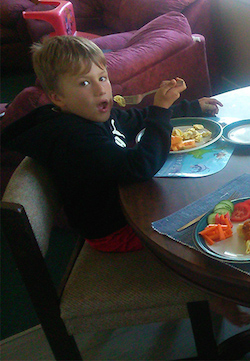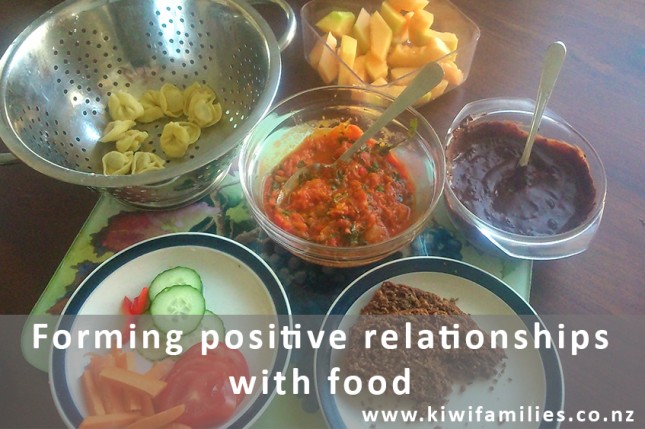Food has become such a hot topic. Everywhere we turn there are messages bombarding us about what we should eat and how we should feel while we’re eating it. If we’re confused, how must our children be feeling? Sometimes it feels like forming positive relationships with food is impossible.
I spent four and a half years learning about nutrition and the reality is that the more I learnt the more relaxed I became about my food choices. Is that chocolate bar going to kill me? Probably not. Is eating it all the time going to do me any favours? Probably not either. And so it is with our children.
Forming positive relationships with food: Restricting food
Restricting food choices doesn’t work. It doesn’t matter what the reasons, it doesn’t work. I get that too much sugar causes tooth decay. I get that we have an obesity problem among our children, and adults. I get that there are foods that contain lots of numbers that make the food more scientific than food. I get that we want the best for our children. I get that restricting food is done with the best of intentions. But it is still restriction.
Let me ask you this: When you want something and it isn’t available, how do you feel? For most it becomes even more desirable, that’s when you can’t stop thinking about it, you must have it. It doesn’t matter if it’s the latest iPhone or that gooey caramel slice. When we’re told no our brain kicks into overdrive screaming YES! And we, as adults, have supposedly way more self-control and thought processes than children so we can easily avoid giving into these yes signals. Right?
So how can we expect our children to listen to no and respond by eating a healthy diet when we struggle to do so?
New Zealand’s population of overweight and obese children is growing as is our population of children with eating disorders. Restricting food and emphasising healthy and unhealthy food is not working. So what can we do instead?
Forming positive relationships with food: Trust them to know their own bodies.
What??? I hear you say. Believe it or not children up to the age of three or four years are really good at knowing when they are hungry and when they are full. For whatever reasons, and this hasn’t been determined yet, they lose this ability as they get older. My theory is that we as a society and as parents teach them out of it. This isn’t meant to make you feel guilty, as we follow what we were taught. Think about it though, how many times do we question our children. “You can’t be full yet, you’ve still got food on your plate.” “You can’t be hungry, you’ve just had lunch.” This is very normal parent behaviour. Let’s face it, children’s eating habits can be highly frustrating.
Let’s teach them and ourselves how to trust our bodies again. Talk to your children about how they know when they are hungry. Ask them what full feels like for them. How does it feel when they have eaten too much? Or if they are so busy they forget to eat, what does that feel like?
I work with my clients using the Ellyn Satter model of feeding. Learning about this way of providing food has been revolutionary in my home and for my clients.
The basic concept is that it is the parents’ responsibility to choose:
- What food is served.
- When the food is to be served.
- Where the food is served.
The child’s responsibility is to choose:
- What food from that served will be eaten.
- How much will be eaten.
This really works best when all the food is served into the middle of the table and each person can help themselves, with help for young children. This allows children to feel a certain sense of control over their own food choices (within what you have provided). But what happens when they only choose a pile of pasta. The inner you can scream “you need vegetables, you need protein” but outwardly you need to remain calm and non-judgemental about their choices. It is their choice. This outward calm will allow them to make wider choices because they want to. Rather than making choices because it will annoy or please mum/dad, or because they feel they have to.
Forming positive relationships with food: Making their own choices
The idea is that children will begin to feel comfortable making their own choices and recognising when they are hungry and full. They can try new foods because they are right in front of them but there is no pressure to do so until they want to. It also means that they get better at judging how much food they need to eat in response to their hunger. This may mean, at the beginning, that they dish up a pile of food but only eat some of it. Again no comment. They can see that this was too much, they will learn to adjust and serve themselves a more realistic portion. Or you can help by suggesting they take a small amount at first and have some more once this is eaten.
The Ellyn Satter model helps to eliminate the NO factor. When you aren’t saying no the brain won’t be screaming YES so often or as loudly. When all the food is dished into the middle of the table the food all has equal value. In our house we serve dessert at the same time as the rest of the meal. This is to reduce the wow factor of dessert. It becomes just another food. This is a recent change for us but it is working really well. We don’t have dessert every night and when we do there isn’t the option for seconds as there is with the rest of the meal. As the novelty wears off and it is clear that it will happen again your family will eat it because they like it not because it has a higher status. It is not uncommon for dessert to be declined altogether or half eaten. Other nights it is demolished. Sometimes it is eaten first, other times interspersed between mouthfuls of meat and veg.
Children don’t care about health they care about flavour and the yum factor.
This is where it is all going a bit wrong. In a child’s mind unhealthy = yum!!! and healthy = has to eat it so must taste yuck!!! Ok so this is definitely not the case all the time but the reality is the more we push the healthy stuff and really encourage our kids to eat their vegetables the more they wonder why. If they tasted good in the first place why would they need to be convinced? They’d just know right? So I say let them find out for themselves. Offer them a variety, let them watch you enjoy those brightly coloured flavour packed vegetables and wonder what all the excitement is about. And I know it’s not true for all adults but I love vegetables. I eat them for their flavour and the added benefit is that they are good for me and make me feel good. The reality is though that if I don’t like them I don’t eat them. Aubergine for example is not on my favoured list. It’s just too squishy so I only eat it to be polite if it is served to me.
Forming positive relationships with food: Provide them with the tools and skills
By allowing our children to eat dessert, cakes and lollies, they may be eating food that is less nutritious than others but we as parents can only control our children’s eating for a short time. As children get older they have access to every food imaginable and it is better that they have the skills and ability to make food choices that will help them to stay healthy and happy rather than feeling like Willie Wonker in his candy store after his dentist dad didn’t allow him to have candy.
Eat for flavour, eat for enjoyment, eat to make your body feel good and eat without guilt.








